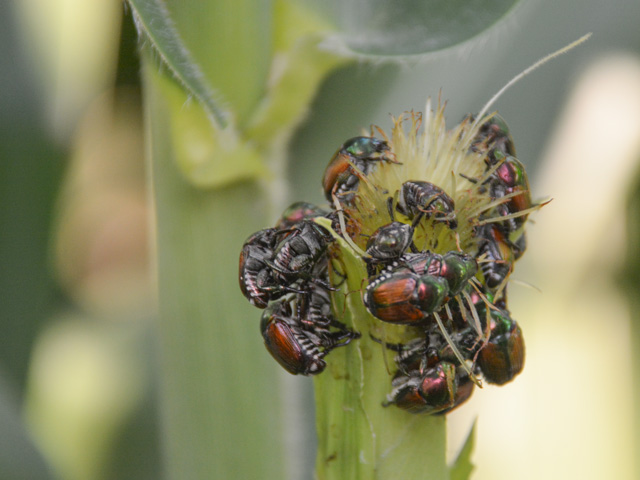Monitor Corn Now for Silk Feeding
Corn Yields Can be Eaten Away by Insect Silk Clipping
ANKENY, Iowa (DTN) -- The buffet is open for several pests that love to feast on corn silks, which could hamper pollination and reduce yields if damage and pest numbers are significant.
Cornfields are tasseling and silks are out across the Midwest, but development is staggered. Late July is a good time to scout fields for the primary silk munchers -- Japanese beetle, adult corn rootworm beetles, grasshoppers and corn earworm -- to see if management steps should be taken.
Silk clipping by pests can interfere with pollination, according to Iowa State University Extension Entomologist Specialist Erin Hodgson. She recently wrote an article on the subject: https://crops.extension.iastate.edu/…. Pest damage can reduce the number of kernels and/or kernel weight.
"Many insects like to feed on silks, so it is a critical time to assess pollination rates," Hodgson wrote.
Here are scouting and treatment recommendations from Hodgson.
JAPANESE BEETLES
Japanese beetles mate and feed in groups, and are particularly attracted to green silks. It's common to see the insects aggregated on plants, especially along edge rows.
Adult management can be frustrating, according to Hodgson. Japanese beetles are highly migratory but, for the most part, only travel far enough in fields to find a meal. Cautionary applications are often not economic.
If Japanese beetles are actively feeding on silks, determine densities to make smart treatment decisions. Consider an insecticide registered for management if three or more beetles are found per ear, silks have been clipped to less than an inch and pollination isn't complete. Hodgson recommends farmers alternate insecticides if a second application is needed to prevent resistance development.
P[L1] D[0x0] M[300x250] OOP[F] ADUNIT[] T[]
"Data from my lab shows good efficacy when adults are contacted directly by the spray," Hodgson wrote. "I don't expect a long residual as additional adults move into the field."
CORN ROOTWOM
Emergence of western and northern corn rootworm beetles are occurring, Hodgson said. Like Japanese beetles, they also like green silks and mate and feed in masses.
"Corn rootworms have a long emergence period and new adults will continue to emerge for several weeks," Hodgson told DTN. "Continue to scout fields past the pollination period to better understand adult activity."
Consider an insecticide treatment if five or more corn rootworm beetles are found per ear, silks have been clipped to less than 1 inch and pollination is not complete. The treatment threshold can be bumped up to 15 beetles per ear if the field has adequate moisture, Hodgson said.
GRASSHOPPERS
Grasshopper nymphs and adults occasionally eat corn silks, according to Hodgson. Field borders are the place to find grasshoppers early in the growing season, but they move to interior portions of fields later in the summer.
Hodgson said grasshopper densities are often hard to determine and only take action if they are interfering with pollination.
"Because grasshoppers tend to move short distances and attack border rows first, a border treatment may be a cost-effective decision," Hodgson wrote.
CORN EARWORM
Corn earworm larvae can feed on silks before moving into the ear to feed on kernels. The larvae can be yellow, green, orange, brown or even purple in color. They have alternating dark and light stripes running the length of their body, which is rough to the touch.
Females lay eggs on silks at night. First instars will feed on silks and eventually move inside the tip of the ear.
"Since killing the larvae once they reach the inside of the ear is almost impossible, I recommend monitoring adults," Hodgson wrote. "The University of Illinois has a website, http://ipm.illinois.edu/…, that summarizes how to properly time a foliar treatment for corn earworm, depending on the type of corn grown."
For more information on insect management, read the following DTN stories:
-- www.dtnpf.com/agriculture/web/ag/news/article/2019/06/01/beetle-beware
-- www.dtnpf.com/agriculture/web/ag/news/article/2018/07/06/japanese-beetles-keep-calm-scout
Matthew Wilde can be reached at matt.wilde@dtn.com
Follow him on Twitter @progressivwilde
(c) Copyright 2021 DTN, LLC. All rights reserved.






